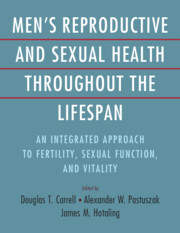 Men's Reproductive and Sexual Health Throughout the Lifespan
Men's Reproductive and Sexual Health Throughout the Lifespan Book contents
- Men’s Reproductive and Sexual Health throughout the Lifespan
- Men’s Reproductive and Sexual Health throughout the Lifespan
- Copyright page
- Contents
- Contributors
- Preface
- Section 1 An Introduction to Men’s Health Care
- Section 2 The Biology of Male Reproduction and Infertility
- Chapter 4 Current Understanding of the Physiology and Histology of Human Spermatogenesis
- Chapter 5 Male Reproductive Endocrinology
- Chapter 6 Sperm Chromatin Packaging and the Toroid Linker Model
- Chapter 7 Ejaculation and Sperm Transport
- Chapter 8 Genetic Aspects of Male Infertility
- Chapter 9 The Mechanistic and Predictive Utility of Sperm Epigenetics
- Chapter 10 Aging and Environmental Interactions with the Sperm Epigenome
- Chapter 11 The Effects of Aging on Male Fertility and the Health of Offspring
- Section 3 Clinical Evaluation and Treatment of Male Infertility
- Section 4 Laboratory Evaluation and Treatment of Male Infertility
- Section 5 Medical and Surgical Management of Issues of Male Health
- Index
- References
Chapter 5 - Male Reproductive Endocrinology
from Section 2 - The Biology of Male Reproduction and Infertility
Published online by Cambridge University Press: 06 December 2023
- Men’s Reproductive and Sexual Health throughout the Lifespan
- Men’s Reproductive and Sexual Health throughout the Lifespan
- Copyright page
- Contents
- Contributors
- Preface
- Section 1 An Introduction to Men’s Health Care
- Section 2 The Biology of Male Reproduction and Infertility
- Chapter 4 Current Understanding of the Physiology and Histology of Human Spermatogenesis
- Chapter 5 Male Reproductive Endocrinology
- Chapter 6 Sperm Chromatin Packaging and the Toroid Linker Model
- Chapter 7 Ejaculation and Sperm Transport
- Chapter 8 Genetic Aspects of Male Infertility
- Chapter 9 The Mechanistic and Predictive Utility of Sperm Epigenetics
- Chapter 10 Aging and Environmental Interactions with the Sperm Epigenome
- Chapter 11 The Effects of Aging on Male Fertility and the Health of Offspring
- Section 3 Clinical Evaluation and Treatment of Male Infertility
- Section 4 Laboratory Evaluation and Treatment of Male Infertility
- Section 5 Medical and Surgical Management of Issues of Male Health
- Index
- References
Summary
The main functions of the male reproductive system are the synthesis and secretion of male sex steroids (androgens), production of male gametes (spermatozoa), and transport of sperm into the female genital tract. The development, maturation, and normal function of male fertility are mainly under the control of the hypothalamic-pituitary-testicular axis, which constitutes the hormonal component of an interplaying and intercommunicating neuronal and endocrine system, that will be explained in this chapter.
Keywords
- Type
- Chapter
- Information
- Men's Reproductive and Sexual Health Throughout the LifespanAn Integrated Approach to Fertility, Sexual Function, and Vitality, pp. 34 - 53Publisher: Cambridge University PressPrint publication year: 2023


